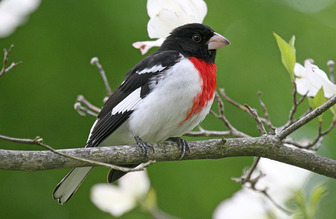Rose-breasted Grosbeak
The Rose-breasted Grosbeak, Pheucticus ludovicianus, is a large seed-eating songbird in the cardinal family . It breeds in cool-temperate North America, migrating to tropical America in winter.

Original source: http://flickr.com/photos/15512543@N04/2488560129/
Author: John Harrison at http://flickr.com/photos/15512543@N04/Permission(Reusing this file)Creative Commons Attribution Sharealike
The Rose-breasted Grosbeak is classified as Least Concern. Does not qualify for a more at risk category. Widespread and abundant taxa are included in this category.
The Rose-breasted Grosbeak, Pheucticus ludovicianus, is a large seed-eating songbird in the cardinal family (Cardinalidae). It breeds in cool-temperate North America, migrating to tropical America in winter. More
The Rose-breasted Grosbeak is a member of the cardinal family, and reaches a length of 19 cm in adulthood. Its preferred breeding habitat includes open, deciduous woodlands in Canada and the eastern United States. Northern populations will migrate in winter months to southern Mexico and Central America, including Peru and Venezuela. This species is rarely found in Western Europe as well. These birds forage for food in shrubs and trees, and diets consist of insects, seeds and berries. More
The male Rose-breasted Grosbeak is a striking bird with a bold black and white plumage, punctuated by a deep rose triangle in the middle of the white breast. The female's plumage is completely different and resembles a large brown streaky sparrow. The Rose-breasted Grosbeak spends much of its time in the treetops and its song and distinctive metallic, chink, call-note, makes it easier to find. Unlike many songbirds, both the male and female Rose-breasted Grosbeaks are known to sing. More
The male Rose-breasted Grosbeak, boldly patterned in black, white, and rose, is easily identified. The drab, striped female, however, is more of a challenge, resembling a large sparrow or finch. A common bird of forests and second growth, the grosbeak's song is like that of the robin, only as sung by an opera singer, being mellower and more sweetly melodic. More
The Rose-breasted Grosbeak's breeding habitat is open deciduous woods across most of Canada and the northeastern USA. In particular the northern birds migrate south through the United States east of the Rocky Mountains, to winter from central-southern Mexico through Central America and the Caribbean to Peru and Venezuela. The southern limit of its wintering range is not well known; it was for example only recorded in the Serranía de las Quinchas (Colombia) in the 1990s. More
The rose-breasted grosbeak is quite a distinguished and handsome bird. This spring they arrived late as usual on May 5th and left early on August 14th. The males make an appearance before the females (who are later still- no surprise to any dating couple). Our first summer in this home, we were thrilled to be able to easily identify this special bird. More
to have had a reason to handle a Rose-breasted Grosbeak can vouch for. (I can tell you that taking one out of a mist net is an experience not soon forgotten.) Beyond the birdbander-scarring bill they share, the male and female bear little resemblance to each other, and might easily be mistaken for two separate species. The male is a boldly patterned bird, mostly black and white, with a black head, throat, and back. More
female-plumaged Rose-breasted Grosbeak but has buffier breast and has streaking confined to the sides. HABITAT: Open woodlands near water, thick brush, large trees near open areas, marsh borders, overgrown pastures, dense growth of small trees, woodland edges, gardens, parks. NESTING & FEEDING: BREEDING: Deciduous forest, woodland, second growth. 1 or 2 broods. Mating system is monogamous. More
The Rose-breasted Grosbeak, Pheucticus ludovicianus, is a large seed-eating bird in the cardinal family. The adult is 19 cm long and weighs 47 g. It has dark upperparts, white underparts and a large pale bill. The adult male has a black head, wings and upperparts and a bright rose-red patch on its breast; the wings have white patches and rose red linings. The adult female has dark grey upperparts, a white stripe over the eye, streaked underparts and yellowish wing linings. More
Rose-breasted Grosbeak ID TipsIdentification tips for the Rose-breasted Grosbeak Range Maps: (Click map to enlarge.) R-B Grosbeak Breeding Map R-B Grosbeak Winter Map USGS Breeding Map Winter Map (CBC) Additional Information: Cornell Lab of Ornithology Photo, description, similar species, sound, range, habitat, food, behavior, reproduction, and conservation status. More
Description: Rose-Breasted Grosbeaks are common in forests and wooded areas in the northeastern United States and Canada. The heavy bill of the Rose-Breasted Grosbeak is used to glean food, such as insects, seeds and fruits, from trees. This bird breeds from southern Yukon southeastward to northern North Dakota, eastward to Newfoundland, and southward to Nebraska, New Jersey, and in the mountains to northern Georgia. It winters from southern Mexico to northern South America and the Caribbean. More
The male Rose-breasted Grosbeak should not present any problem in identification. The breast and lining of wings are a bright rose color while rest of underparts and the rump are white. The head, chin, and back are black as are the wings and tail which also have white markings. The bill is grayish white. But the female, entirely different in plumage markings, suggests an overgrown sparrow or finch. The size and shape of her bill, however, will indicate her identity as a grosbeak. More
The Rose-breasted Grosbeak is one of five species of grosbeaks that occur in North America. The Rose-breasted, Black-headed and Blue Grosbeaks, members of the family Emberizidae (buntings, sparrows), are Neotropical migrants that nest in the USA but withdraw to Mexico and Central America in the winter months. The Pine and Evening Grosbeaks, members of the family Fringillidae (finches, crossbills) are resident in North America. All have a characteristic massive bill. More

Original source: Arthur Chapman
Author: Arthur Chapman
Permission: Some rights reserved
Family : Cardinalidae
Genus : Pheucticus
Species : ludovicianus
Authority : (Linnaeus, 1766)
